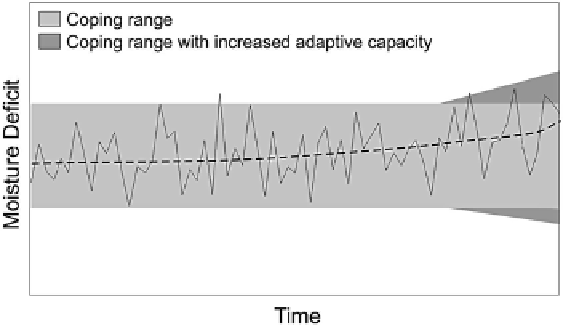Geoscience Reference
In-Depth Information
Fig. 4.1
Coping range and extreme events (Smit and Wandel
2006
)
As human systems adapt to local conditions, they will develop an ability to cope
with slight-to-moderate variations in local climate stimuli (Smit and Pilifosova
2001
). This concept is illustrated graphically as a
coping range
in Fig.
4.1
. The
system depicted is able to cope with moderate variations in the moisture defi cit,
perhaps due to strategies such as rainwater harvesting to make it through drier years
or the implementation of drainage systems to make it through wetter years. It is only
vulnerable to levels of moisture defi cit that breach the upper and lower
coping
thresholds
, for example, in the case of a drought or fl ood. Though depicted as a fi ne
line, in reality, coping thresholds are more likely to resemble gradations, in which
the system is increasingly vulnerable to greater deviation from the mean.
Coping thresholds are dynamic. The coping range could contract due to a variety
of factors, both exogenous and endogenous to the system. For example, a moisture
defi cit that is high, but not beyond the coping threshold, may not cause a disaster
immediately, but it could result in a depletion of savings and thereby reduce the cop-
ing range. Subsequent years of the same high moisture defi cit may then surpass the
coping threshold (Smit and Pilifosova
2003
). This topic is primarily concerned with
climate-related shocks - sudden onset events like hurricanes, droughts, fl ooding and
fi res. However, it is important for vulnerability assessments to also consider climate-
and non-climate-related stresses - slow onset trends like sea level rise, desertifi ca-
tion, population growth, urbanization and globalization - that can undermine human
systems' ability to absorb and recover from disturbances.
The coping range could also expand. A system's adaptive capacity refers its ability
to expand or shift its coping range in response to changes in the climate, such as
changes in the frequency or magnitude of extreme events. As seen on the right-hand
side of Fig.
4.1
, the system depicted was capable of adapting to an increase in the
average moisture defi cit, perhaps through new coping strategies such as the use of
drip irrigation, crop insurance or EWSs. Similar graphical representations can be

Search WWH ::

Custom Search